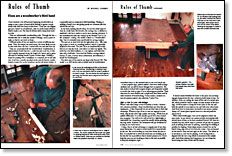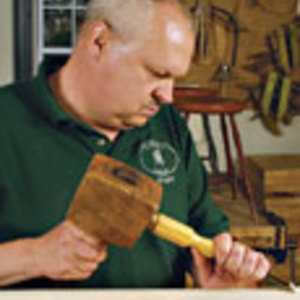Vises Are a Woodworker’s Third Hand
How to choose and use the right one for your workbench
Synopsis: Vises are indispensable woodworking tools. Different styles are made for a variety of different purposes, and author Michael Dunbar explains how and where to mount them. He describes common types, such as side and tail vises, and others, such as a Prentise carriage-maker’s vise and a pattern-maker’s vise. Then he explains how to use the vise to your advantage and how to avoid common problems.
I have watched a lot of frustrated beginning woodworkers attempt to saw a piece of wood while holding it against a workbench with their free hand or their knee. I even saw one diligent guy put a board on a workbench, then sit on the board while he tried to make a cut. Pity that all of them didn’t clamp their work in a vise.
Vises are indispensable woodworking tools. Through the day, a woodworker has to hold any number of things, such as parts or tools, so that he can work on them.
Different styles of vises are made for a variety of different purposes. Thus, the longer you work wood, the more likely you are to own more than one vise. I started with one and now have six.
Vises are commonly built into woodworkers’ workbenches. A typical joiner’s bench has two—a side vise and a tail vise. A side vise is usually mounted along the length of a bench and is generally used for holding boards or parts on their edges. Holding a board for jointing with a handplane is a common job for the side vise. A tail vise—usually mounted on the end of a bench—holds boards or parts flat on the benchtop (see the left photo below). It is generally used in conjunction with benchdogs. Planing or sanding a board’s face and gluing panels are common jobs that involve the tail vise.
In my chair-making school’s shop, we use two other types of vises on a daily basis. My favorite, the carriage vise, is similar to a machinist’s vise but is made to much more exacting tolerances. It was manufactured early this century by the Prentise Vise Co. In the company’s catalog, this model is listed as a “woodworker’s vise,” but it is intended more specifically for carriage makers.
The jaws are at chest level (see the right photo on p. 108), making it easier to work in a standing position, which is especially helpful for fine work. The jaws’ faces are machined flat so that they do not mar the work, even when it is held very tightly. The screw has very little backlash, so I can tighten and loosen the jaws with a half twist. I have had the Prentise carriage-maker’s vise for 27 years. It serves me as a third hand, and without.it, I would feel handicapped.
The other type of vise used in our shop is the Record 53E. This model is so well known and so widely used by woodworkers everywhere that it is the standard add-on cast-iron bench vise.
From Fine Woodworking #133
For the full article, download the PDF below:
Fine Woodworking Recommended Products

Lie-Nielsen No. 102 Low Angle Block Plane

Hedgehog featherboards

Veritas Micro-Adjust Wheel Marking Gauge























Log in or create an account to post a comment.
Sign up Log in